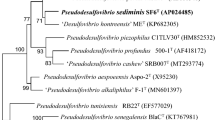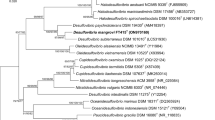Abstract
Desulfovibrio strain JJ isolated from estuarine sediment differed from all other described Desulfovibrio species by the ability to degrade fructose. The oxidation was incomplete, leading to acetate production. Fructose, malate and fumarate were fermented mainly to succinate and acetate in the absence of an external electron acceptor. The pH and temperature optima for growth were 7.0 and 35° C respectively. Strain JJ was motile by means of a single polar flagellum. The DNA base composition was 64.13% G+C. Cytochrome c 3 and desulfoviridin were present. These characteristics established the isolate as a new species of the genus Desulfovibrio, and the name Desulfovibrio fructosovorans is proposed.
Similar content being viewed by others
References
Balch WE, Fox GE, Magrum LJ, Wolfe RS (1979) Methanogens: reevaluation of a unique biological group. Microbiol Rev 43: 260–296
Braun M, Stolp H (1985) Degradation of methanol by a sulfate reducing bacterium. Arch Microbiol 142:77–80
Cord-Ruwisch R (1985) A quick method for the determination of dissolved and precipitated sulfides in cultures of sulfate-reducing bactria. J Microbiol Meth 4:33–36
Cord-Ruwisch R, Ollivier B, Garcia JL (1986) Fructose degradation by Desulfovibrio sp. in pure culture and in coculture with Methanospirillum hungatei. Curr Microbiol 13:285–289
Hatchikian EC (1972) Mécanismes d'oxydo-réduction chez les bactéries sulfato-réductrices. Thèse doctorat d'état, Université d'Aix-Marseille II, France
Hatchikian EC, Le Gall J (1970a) Étude du métabolisme des acides dicarboxyliques et du pyruvate chez les bactéries sulfato-réductrices. I. Étude de l'oxydation enzymatique du fumarate en acétate. Ann Inst Pasteur 118:125–142
Hatchikian EC, Le Gall J (1970b) Étude du métabolisme des acides dicarboxyliques et du pyruvate chez les bactéries sulfato-réductrices. II. Transport des électrons, accepteurs finaux. Ann Inst Pasteur 118:288–301
Hungate RE (1969) A roll tube method for the cultivation of strict anaerobes. In: Norris JR, Ribbons DW (eds) Methods in microbiology, vol 3 B. Academic Press, New York, pp 117–132
Jones WJ, Guyot JP, Wolfe RS (1984) Methanogenesis from sucrose by defined immobilized consortia. Appl Environ Microbiol 47:1–6
Jorgensen BB, Frenchel T (1974) The sulfur cycle of a marine sediment model system. Marine Biol 24:189–201
Klemps R, Cypionka H, Widdel F, Pfennig N (1985) Growth with hydrogen, and further physiological characteristics of Desulfotomaculum species. Arch Microbiol 143:203–208
Lee JP, Peck HD Jr (1971) Purification of the enzyme reducing bisulfite to trithionate from Desulfovibrio gigas and its identification as desulfoviridin. Biochem Biophys Res Commun 45:583–589
Lowry OH, Rosebrough NJ, Farr AL, Randall RJ (1951) Protein measurement with the Folin phenol reagent. J Biol Chem 193:265–275
Marmur J (1961) A procedure for the isolation of deoxyribonucleic acid from microorganisms. J Mol Biol 3:2317–2324
Miller JDA, Wakerley DS (1966) Growth of sulphate-reducing bacteria by fumarate dismutation. J Gen Microbiol 43:101–107
Miller JDA, Neuman PM, Elford L, Wakerley DS (1970) Malate dismutation by Desulfovibrio. Arch Microbiol 71:214–219
Möller B, Obmer R, Howard BH, Gottschalk G, Hippe H (1984) Sporomusa, a new genus of Gram-negative anaerobic bacteria including Sporomusa sphaeroides spec. nov. and Sporomusa ovata spec. nov. Arch Microbiol 139:388–396
Nanninga HJ, Gottschal JC (1986) Isolation of a sulfate-reducing bacterium growing with methanol. FEMS Microbiol Ecol 38:125–130
Pfennig N (1978) Rhodocyclus purpureus gen. nov. and sp. nov., a ring shape, vitamin B12-requiring member of the family Rhodospirillaceae. Int J Syst Bacteriol 28:283–288
Pfennig N, Widdel F, Trüper HG (1981) The dissimilatory sulfate-reducing bacteria. In: Starr MP, Stolp H, Trüper HG, Balows A, Schlegel HG (eds) The prokaryotes. Springer, Berlin Heidelberg New York, pp 926–940
Postgate JR (1956) Cytochrome c 3 and desulphoviridin; pigments of the anaerobe Desulphovibrio desulphuricans. J Gen Microbiol 14:545–572
Postgate JR (1959) A diagnostic reaction of Desulphovibrio desulphuricans. Nature 183:481–482
Postgate JR (1979) The sulfate reducing bacteria. Cambridge University Press, London
Stams AJM, Hansen TA, Skyring GW (1985) Utilization of amino acids as energy substrates by two marine Desulfovibrio strains. FEMS Microbiol Ecol 31:11–15
Widdel F (1980) Anaerober Abbau von Fettsäuren und Benzoesäure durch neu isolierte Arten Sulfat-reduzierender Bakterien. Doctoral thesis, Univ Göttingen, FRG
Widdel F, Pfennig N (1984) Dissimilatory sulfate-or sulfur-reducing bacteria. In: Krieg NR, Holt JG (eds) Bergey's manual of systematic bacteriology, 9th edn. Williams and Wilkins, Baltimore, pp 663–679
Author information
Authors and Affiliations
Rights and permissions
About this article
Cite this article
Ollivier, B., Cord-Ruwisch, R., Hatchikian, E.C. et al. Characterization of Desulfovibrio fructosovorans sp. nov.. Arch. Microbiol. 149, 447–450 (1988). https://doi.org/10.1007/BF00425586
Received:
Accepted:
Issue Date:
DOI: https://doi.org/10.1007/BF00425586




